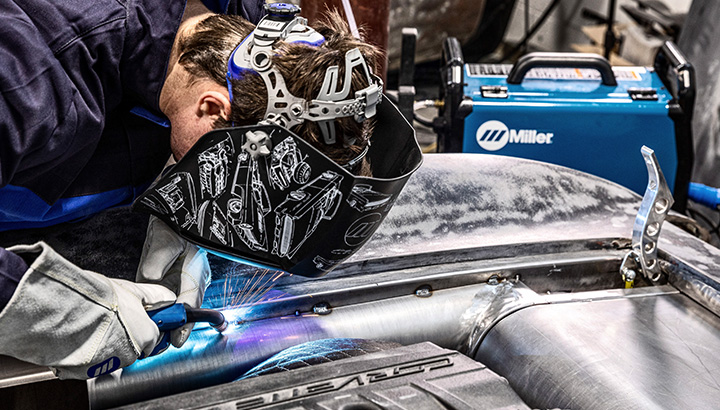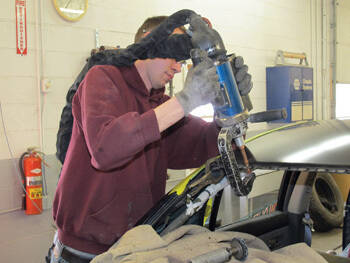Everything about Welding: Trick Insights Into Techniques and Best Practices for Success
Welding includes a variety of techniques, each matched for particular materials and applications. Understanding these techniques, such as GMAW, SMAW, and TIG, is vital for accomplishing suitable results. The right equipment and security methods can not be forgotten. As preparation and troubleshooting play crucial functions in the welding process, grasping these elements can significantly enhance the quality of the end product. What are the essential elements that assure a successful weld?
Recognizing Various Welding Methods
Welding techniques include a variety of techniques, each matched to specific applications and materials. Among the most usual techniques are Gas Metal Arc Welding (GMAW), Shielded Steel Arc Welding (SMAW), and Tungsten Inert Gas Welding (TIG) GMAW, additionally referred to as MIG welding, is popular for its speed and versatility, making it perfect for thin products. SMAW, or stick welding, is preferred for its simpleness and efficiency in exterior environments, specifically with thicker metals. TIG welding supplies precision and control, making it appropriate for detailed work and non-ferrous steels (Montana Mobile Welding and Repair Fabrication). Each strategy has its special advantages and considerations, allowing welders to choose the most effective method based upon the job's requirements, material kind, and desired outcomes. Recognizing these strategies is important for effective welding
Vital Welding Tools and Tools
While various welding strategies call for particular skills, the right equipment and tools are equally crucial for accomplishing top quality outcomes. Essential welding tools consists of welding makers, which vary depending upon the method-- such as MIG, TIG, or stick welding. Protective gear, including headgears, handwear covers, and aprons, warranties safety and convenience throughout the process. In enhancement, fixtures and clamps assist safeguard materials in location, ensuring precision in welds. Consumables like welding poles, cable, and shielding gas are likewise essential components that affect the top quality of the weld. Tools such as mills and cutters assist in surface area prep work and post-weld completing, contributing to a professional result. Buying top quality devices eventually enhances the efficiency and efficiency of welding tasks.
Safety And Security Practices in Welding
Correct security practices are crucial in the welding market to secure workers from possible risks. Welders need to put on appropriate individual protective devices (PPE), consisting of safety helmets with correct shading, gloves, and flame-resistant garments. Appropriate ventilation is essential to minimize direct exposure to harmful fumes and gases generated throughout the welding process. Additionally, workers should be educated in the correct handling of welding devices to stop accidents. Fire safety measures, such as keeping combustible materials away from the welding area and having fire extinguishers conveniently offered, are essential. Routine evaluations of devices and work areas can assist recognize possible threats prior to they bring about mishaps. By adhering to these safety and security techniques, welders can produce a more secure working atmosphere and reduce risks related to their trade.
Preparing Materials for Welding
Preparing products for welding is an essential action that greatly affects the quality and honesty of the end product (Montana Mobile Welding and Repair Fabrication). Appropriate prep work includes cleaning up the surfaces to eliminate impurities such as corrosion, dust, and oil, which can compromise the weld. Strategies such as grinding, fining sand, or using solvents are frequently employed to accomplish a clean surface area. Additionally, ensuring that the products fit with each other comfortably is crucial; gaps can lead to weak welds. It's additionally important to take right into account the positioning and positioning of the components, as this will certainly impact the ease of welding and the last end result. Selecting the ideal filler material and making certain compatibility with the base steels is vital for accomplishing strong, resilient welds.
Tips for Getting High-Quality Welds
Attaining top notch welds needs attention to information and adherence to best techniques throughout the welding process. Proper joint prep work is necessary, ensuring surfaces are clean and totally free from impurities. Choosing the suitable filler material and welding technique based upon the base steels is critical for perfect bonding. Preserving regular travel rate and angle while welding can promote and stop issues uniformity. Furthermore, controlling heat input is necessary; too much warmth can result in bending and weakened joints. Frequently checking the welds during the process permits instant changes if required. Finally, utilizing proper post-weld therapies, such as cleaning and anxiety relief, can boost the toughness and integrity of the weld, eventually ensuring a successful outcome.
Fixing Usual Welding Issues
Welding commonly presents difficulties that can affect the quality and integrity of the end product. Common issues such as porosity, inconsistent weld grains, and getting too hot can occur, each needing particular troubleshooting methods. Recognizing these troubles is essential for welders to boost their abilities and accomplish suitable results.
Porosity Problems Clarified
Although porosity can frequently be overlooked, it continues to be a vital problem in welding that can endanger the honesty of an ended up item. Porosity refers to the visibility of small gas pockets within the weld grain, which can damage the joint and lead to early failing. This issue usually arises from contaminants, moisture, or improper securing gas coverage throughout the welding procedure. To reduce porosity, welders ought to validate that the base materials are tidy and completely dry, make use of appropriate shielding gases, and keep consistent welding criteria. Routinely evaluating the devices and atmosphere can likewise aid identify possible issues before they materialize in the weld. Attending to porosity effectively is important for achieving solid, sturdy welds that meet quality criteria.

Inconsistent Weld Beads
Irregular weld grains can substantially influence the top quality and stamina of a completed item. Numerous factors add to this issue, consisting of incorrect traveling rate, inaccurate amperage setups, and irregular electrode angles. When the welder moves too rapidly, a grain might show up slim and do not have penetration, while relocating also gradually can trigger too much buildup. Additionally, using the wrong amperage can cause either damaging or too much spatter, both of which concession weld honesty. The welder's technique, such as irregular lantern motion, can likewise cause uneven bead look. To minimize these troubles, welders must focus on preserving consistent, regulated activities and Visit Your URL ensuring correct tools settings to achieve uniformity in their welds. Uniformity is key to attaining dependable and solid welds.
Getting Too Hot and Warping Issues
Extreme warm during the welding procedure can lead to substantial overheating and buckling concerns, affecting the structural stability of the work surface. These problems commonly show up as distortion, which can endanger positioning and fit-up, making additional assembly challenging. Aspects contributing to overheating include the choice of welding specifications, such as voltage and travel rate, as well as the sort of product being bonded. To minimize these problems, welders ought to maintain constant travel speed and suitable warm input while checking the work surface temperature. Furthermore, pre-heating or post-weld warmth therapy can aid alleviate stresses triggered by fast air conditioning - Welding. Regular inspection and adherence to best methods are vital in avoiding getting too hot and making sure the long life and integrity of bonded structures
Frequently Asked Inquiries
What Are the Job Opportunities in the Welding Market?
The welding industry supplies varied job chances, consisting of placements as welders, inspectors, designers, and teachers. Experts can work in manufacturing, building and construction, aerospace, and automotive markets, taking advantage of solid need and affordable salaries in different functions.
Just How Can I Improve My Welding Speed Without Sacrificing Top Quality?
To boost welding speed without sacrificing high quality, one need to exercise reliable strategies, maintain devices, maximize settings, and boost hand-eye coordination. Routine training and seeking comments can also greatly add to achieving faster, top notch welds.
What Accreditations Are Offered for Welders?
Various qualifications exist for welders, including those from the American Welding Society (AWS), the National Center for Building And Construction Education and Research (NCCER), and numerous industry-specific companies. These qualifications boost employability and demonstrate skill proficiency.
How Does Welding Affect the Properties of Metals?
Welding influences the properties of steels by altering their microstructure, Learn More Here which can result in adjustments in stamina, ductility, and solidity. Warm input and cooling rates throughout the process substantially affect these product characteristics.
Can I Weld Dissimilar Metals Together?
